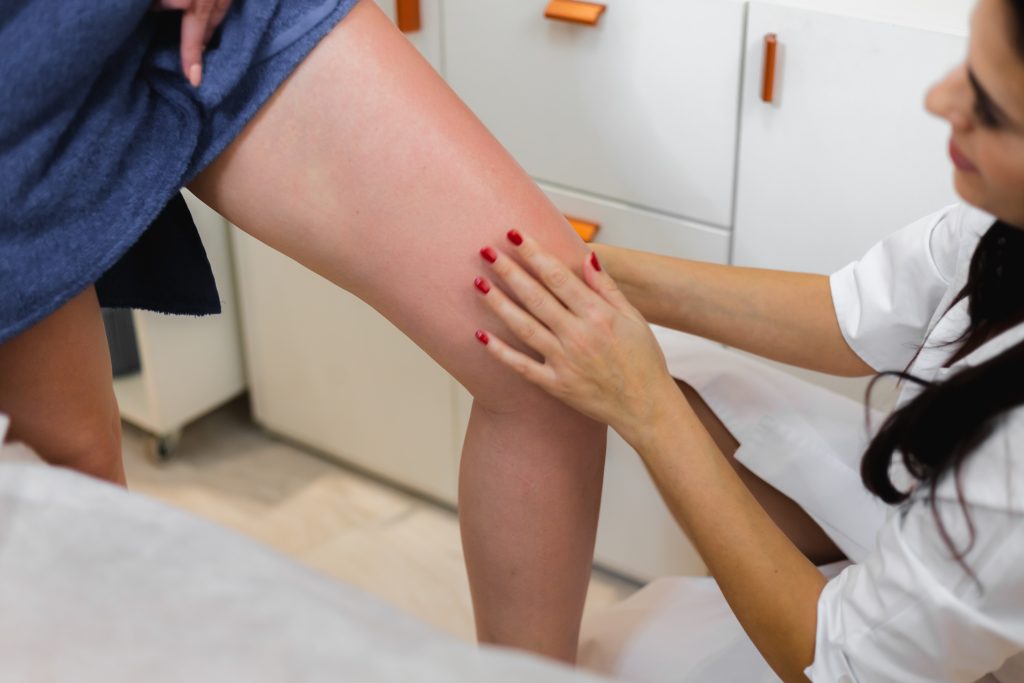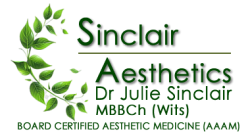Sclerotherapy

What Are Spider Veins?
Spider veins – known in the medical world as telangiectasias or sunburst varicosities – are small, thin veins that lie close to the surface of the skin. Although these super-fine veins are connected with the larger venous system, they are not an essential part of it. A number of factors contribute to the development of spider veins, including heredity, pregnancy and other events that cause hormonal shifts, weight gain, occupations or activities that require prolonged sitting or standing, and the use of certain medications.
Spider veins usually take on one of three basic patterns. They may appear in a true spider shape with a group of veins radiating outward from a dark central point; they may be arborizing and will resemble tiny branch-like shapes; or they may be simple linear and appear as thin separate lines. Linear spider veins are commonly seen on the inner knee, whereas the tree-like pattern often appears on the outer thigh in a sunburst or cartwheel distribution.
Varicose veins differ from spider veins in a number of ways. Varicose veins are larger – usually more than a quarter-inch in diameter, darker in color and tend to bulge. Varicose veins are also more likely to cause pain and be related to more serious vein disorders. For some patients, sclerotherapy can be used to treat varicose veins. However, often surgical treatment is necessary for this condition.
The Best Candidates For Sclerotherapy:
Women of any age may be good candidates for sclerotherapy, but most fall in the 30-to-60 category. In some women, spider veins may become noticeable very early on – in the teen years. For others, the veins may not become obvious until they reach their 40s. If you are pregnant or breastfeeding, you may be advised to postpone sclerotherapy treatment. In most cases, spider veins that surface during pregnancy will disappear on their own within three months after the baby is born. Also, because it’s not known how sclerosing solutions may affect breast milk, nursing mothers are usually advised to wait until after they have stopped breastfeeding.
Spider veins in men aren’t nearly as common as they are in women. Men who do have spider veins often don’t consider them to be a cosmetic problem because the veins are usually concealed by hair growth on the leg. However, sclerotherapy is just as effective for men who seek treatment.
What To Expect From Sclerotherapy?
Sclerotherapy can enhance your appearance and your self confidence, but it’s unrealistic to believe that every affected vein will disappear completely as a result of one treatment. After each sclerotherapy session, the veins will appear lighter. Three or more sessions are usually required to achieve optimal results. You should also be aware that the procedure treats only those veins that are currently visible; it does nothing to permanently alter the venous system or prevent new veins from surfacing in the future.
Before you decide to have sclerotherapy, think carefully about your expectations and discuss them with your doctor.
The Procedure:
A typical sclerotherapy session is relatively quick, lasting only about 15 to 45 minutes. Approximately one injection is administered for every inch of spider vein – anywhere from five to 40 injections per treatment session. Compression tape is applied to each area of the leg as it is finished.
As the procedure continues, you will feel small needle sticks and possibly a mild burning sensation. However, the needle used is so thin and the sclerosing solution is so mild that pain is usually minimal.
Getting Back To Normal:
Although you probably won’t want to wear any leg-baring fashions for about two weeks, your activity will not be significantly limited in any other way from sclerotherapy treatment.
You will be encouraged to walk to prevent clots from forming in the deep veins of the legs. However, during the period of time to complete your treatment program, prolonged sitting and standing should be avoided, as should squatting, heavy weight lifting and “pounding” type exercises, including jogging.
A one-month healing interval must pass before you may have your second series of injections in the same site. After each treatment, you will notice further improvement of your legs’ appearance.
Your New Look:
Most patients are pleased with the difference sclerotherapy makes. The skin of your legs will appear younger, clearer and more healthy-looking. If you’ve been wearing long skirts and slacks to hide your spider veins, you’ll now be able to broaden your fashion horizons. Often, patients are surprised at the dramatic difference in appearance between a treated leg and an untreated one.
Although sclerotherapy will obliterate the noticeable veins for good, it’s important to remember that treatment will not prevent new spider veins from emerging in the future. As time passes, you may find that you need “touch-ups” or full treatments for new veins that surface – this due to Genetic predisposition.
